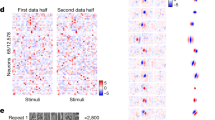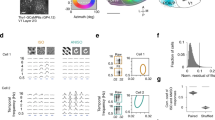Abstract
Neuronal populations in sensory cortex represent time-changing sensory input through a spatiotemporal code. What are the rules that govern this code? We measured membrane potentials and spikes from neuronal populations in cat visual cortex (V1) using voltage-sensitive dyes and electrode arrays. We first characterized the population response to a single orientation. As response amplitude grew, the population tuning width remained constant for membrane potential responses and became progressively sharper for spike responses. We then asked how these single-orientation responses combine to code for successive orientations. We found that they combined through simple linear summation. Linearity, however, was violated after stimulus offset, when responses exhibited an unexplained persistence. As a result of linearity, the interactions between responses to successive stimuli were minimal. Our results indicate that higher cortical areas may reconstruct the stimulus sequence from V1 population responses through a simple instantaneous decoder. Therefore, spatial and temporal codes in area V1 operate largely independently.
This is a preview of subscription content, access via your institution
Access options
Subscribe to this journal
Receive 12 print issues and online access
$209.00 per year
only $17.42 per issue
Buy this article
- Purchase on Springer Link
- Instant access to full article PDF
Prices may be subject to local taxes which are calculated during checkout







Similar content being viewed by others
References
Pouget, A., Dayan, P. & Zemel, R.S. Inference and computation with population codes. Annu. Rev. Neurosci. 26, 381–410 (2003).
Averbeck, B.B., Latham, P.E. & Pouget, A. Neural correlations, population coding and computation. Nat. Rev. Neurosci. 7, 358–366 (2006).
Buonomano, D.V. & Maass, W. State-dependent computations: spatiotemporal processing in cortical networks. Nat. Rev. Neurosci. 10, 113–125 (2009).
Broome, B.M., Jayaraman, V. & Laurent, G. Encoding and decoding of overlapping odor sequences. Neuron 51, 467–482 (2006).
Yu, B.M. et al. Mixture of trajectory models for neural decoding of goal-directed movements. J. Neurophysiol. 97, 3763–3780 (2007).
Civillico, E.F. & Contreras, D. Integration of evoked responses in supragranular cortex studied with optical recordings in vivo. J. Neurophysiol. 96, 336–351 (2006).
Ferster, D. & Miller, K.D. Neural mechanisms of orientation selectivity in the visual cortex. Annu. Rev. Neurosci. 23, 441–471 (2000).
Shapley, R., Hawken, M. & Ringach, D.L. Dynamics of orientation selectivity in the primary visual cortex and the importance of cortical inhibition. Neuron 38, 689–699 (2003).
Sharon, D. & Grinvald, A. Dynamics and constancy in cortical spatiotemporal patterns of orientation processing. Science 295, 512–515 (2002).
Benucci, A., Frazor, R.A. & Carandini, M. Standing waves and traveling waves distinguish two circuits in visual cortex. Neuron 55, 103–117 (2007).
Gillespie, D.C., Lampl, I., Anderson, J.S. & Ferster, D. Dynamics of the orientation-tuned membrane potential response in cat primary visual cortex. Nat. Neurosci. 4, 1014–1019 (2001).
Shevelev, I.A., Sharaev, G.A., Lazareva, N.A., Novikova, R.V. & Tikhomirov, A.S. Dynamics of orientation tuning in the cat striate cortex neurons. Neuroscience 56, 865–876 (1993).
Volgushev, M., Vidyasagar, T.R. & Pei, X. Dynamics of the orientation tuning of postsynaptic potentials in the cat visual cortex. Vis. Neurosci. 12, 621–628 (1995).
Ringach, D.L., Hawken, M.J. & Shapley, R. Dynamics of orientation tuning in macaque primary visual cortex. Nature 387, 281–284 (1997).
Chen, G., Dan, Y. & Li, C.Y. Stimulation of non-classical receptive field enhances orientation selectivity in the cat. J. Physiol. (Lond.) 564, 233–243 (2005).
Ringach, D.L., Hawken, M.J. & Shapley, R. Dynamics of orientation tuning in macaque V1: the role of global and tuned suppression. J. Neurophysiol. 90, 342–352 (2003).
Celebrini, S., Thorpe, S., Trotter, Y. & Imbert, M. Dynamics of orientation coding in area V1 of the awake primate. Vis. Neurosci. 10, 811–825 (1993).
Mazer, J.A., Vinje, W.E., McDermott, J., Schiller, P.H. & Gallant, J.L. Spatial frequency and orientation tuning dynamics in area V1. Proc. Natl. Acad. Sci. USA 99, 1645–1650 (2002).
Nelson, S.B. Temporal interactions in the cat visual system. I. Orientation-selective suppression in visual cortex. J. Neurosci. 11, 344–356 (1991).
Müller, J.R., Metha, A.B., Krauskopf, J. & Lennie, P. Rapid adaptation in visual cortex to the structure of images. Science 285, 1405–1408 (1999).
Felsen, G. et al. Dynamic modification of cortical orientation tuning mediated by recurrent connections. Neuron 36, 945–954 (2002).
Dragoi, V., Sharma, J., Miller, E.K. & Sur, M. Dynamics of neuronal sensitivity in visual cortex and local feature discrimination. Nat. Neurosci. 5, 883–891 (2002).
Duysens, J., Orban, G.A., Cremieux, J. & Maes, H. Visual cortical correlates of visible persistence. Vision Res. 25, 171–178 (1985).
Coltheart, M. Iconic memory and visible persistence. Percept. Psychophys. 27, 183–228 (1980).
Goldberg, J.A., Rokni, U. & Sompolinsky, H. Patterns of ongoing activity and the functional architecture of the primary visual cortex. Neuron 42, 489–500 (2004).
Ben-Yishai, R., Lev Bar Or, R. & Sompolinsky, H. Theory of orientation tuning in the visual cortex. Proc. Natl. Acad. Sci. USA 92, 3844–3848 (1995).
Kenet, T., Bibitchkov, D., Tsodyks, M., Grinvald, A. & Arieli, A. Spontaneously emerging cortical representations of visual attributes. Nature 425, 954–956 (2003).
Oram, M.W., Foldiak, P., Perrett, D.I. & Sengpiel, F. The 'ideal homunculus': decoding neural population signals. Trends Neurosci. 21, 259–265 (1998).
Salinas, E. & Abbott, L.F. Vector reconstruction from firing rates. J. Comput. Neurosci. 1, 89–107 (1994).
Seung, H.S. & Sompolinsky, H. Simple models for reading neuronal population codes. Proc. Natl. Acad. Sci. USA 90, 10749–10753 (1993).
Geisler, W.S. & Albrecht, D.G. Bayesian analysis of identification performance in monkey visual cortex: nonlinear mechanisms and stimulus certainty. Vision Res. 35, 2723–2730 (1995).
Normann, R.A., Maynard, E.M., Rousche, P.J. & Warren, D.J. A neural interface for a cortical vision prosthesis. Vision Res. 39, 2577–2587 (1999).
Grinvald, A. & Hildesheim, R. VSDI: a new era in functional imaging of cortical dynamics. Nat. Rev. Neurosci. 5, 874–885 (2004).
Petersen, C.C., Grinvald, A. & Sakmann, B. Spatiotemporal dynamics of sensory responses in layer 2/3 of rat barrel cortex measured in vivo by voltage-sensitive dye imaging combined with whole-cell voltage recordings and neuron reconstructions. J. Neurosci. 23, 1298–1309 (2003).
Ringach, D.L. & Malone, B.J. The operating point of the cortex: neurons as large deviation detectors. J. Neurosci. 27, 7673–7683 (2007).
Hübener, M. & Bonhoeffer, T. Optical imaging of functional architecture in cat primary visual cortex. in The Cat Primary Visual Cortex (eds Payne, B.R. & Peters, A.) 1–137 (Academic Press, New York, 2002).
Dean, A.F. & Tolhurst, D.J. Factors influencing the temporal phase of response to bar and grating stimuli for simple cells in the cat striate cortex. Exp. Brain Res. 62, 143–151 (1986).
Carandini, M. & Ferster, D. Membrane potential and firing rate in cat primary visual cortex. J. Neurosci. 20, 470–484 (2000).
Azouz, R. & Gray, C.M. Dynamic spike threshold reveals a mechanism for synaptic coincidence detection in cortical neurons in vivo. Proc. Natl. Acad. Sci. USA 97, 8110–8115 (2000).
Chichilnisky, E.J. A simple white noise analysis of neuronal light responses. Network 12, 199–213 (2001).
Xing, D., Shapley, R.M., Hawken, M.J. & Ringach, D.L. Effect of stimulus size on the dynamics of orientation selectivity in macaque V1. J. Neurophysiol. 94, 799–812 (2005).
Schummers, J. et al. Dynamics of orientation tuning in cat V1 neurons depend on the location within layers and orientation maps. Front. Neurosci. 1, 145–159 (2007).
Carandini, M. et al. Do we know what the early visual system does? J. Neurosci. 25, 10577–10597 (2005).
Touryan, J., Lau, B. & Dan, Y. Isolation of relevant visual features from random stimuli for cortical complex cells. J. Neurosci. 22, 10811–10818 (2002).
Tolhurst, D.J., Walker, N.S., Thompson, I.D. & Dean, A.F. Nonlinearities of temporal summation in neurones in area 17 of the cat. Exp. Brain Res. 38, 431–435 (1980).
McCormick, D.A. et al. Persistent cortical activity: mechanisms of generation and effects on neuronal excitability. Cereb. Cortex 13, 1219–1231 (2003).
Carandini, M. & Ringach, D.L. Predictions of a recurrent model of orientation selectivity. Vision Res. 37, 3061–3071 (1997).
Kovács, G., Vogels, R. & Orban, G.A. Cortical correlate of pattern backward masking. Proc. Natl. Acad. Sci. USA 92, 5587–5591 (1995).
Rolls, E.T. & Tovee, M.J. Processing speed in the cerebral cortex and the neurophysiology of visual masking. Proc. Biol. Sci. 257, 9–15 (1994).
Keysers, C., Xiao, D.K., Földiák, P. & Perrett, D.I. Out of sight but not out of mind: the neurophysiology of iconic memory in the superior temporal sulcus. Cogn. Neuropsychol. 22, 316–332 (2005).
Acknowledgements
We thank I. Nauhaus, R.A. Frazor, L. Busse and S. Katzner for help with data acquisition. We thank W.T. Newsome, W.S. Geisler and G. Felsen for helpful discussions. This work was supported by a Scholar Award from the McKnight Endowment Fund for Neuroscience (M.C.) and by US National Institutes of Health grants EY017396 (M.C.) and EY018322 (D.L.R.). M.C. holds the GlaxoSmithKline/Fight for Sight Chair in Visual Neuroscience.
Author information
Authors and Affiliations
Contributions
A.B. and M.C. carried out the experiments, A.B. analyzed the data, and all of the authors contributed to the intellectual development of the project and to the writing of the manuscript.
Corresponding author
Supplementary information
Supplementary Text and Figures
Supplementary Figures 1–3 (PDF 260 kb)
Supplementary Video 1
Decoding the population responses to recover the stimulus orientation. (AVI 6151 kb)
Rights and permissions
About this article
Cite this article
Benucci, A., Ringach, D. & Carandini, M. Coding of stimulus sequences by population responses in visual cortex. Nat Neurosci 12, 1317–1324 (2009). https://doi.org/10.1038/nn.2398
Received:
Accepted:
Published:
Issue Date:
DOI: https://doi.org/10.1038/nn.2398
This article is cited by
-
Dynamic contrast enhancement and flexible odor codes
Nature Communications (2018)
-
Conductance-based refractory density model of primary visual cortex
Journal of Computational Neuroscience (2014)
-
Two-photon voltage imaging using a genetically encoded voltage indicator
Scientific Reports (2013)
-
Adaptation maintains population homeostasis in primary visual cortex
Nature Neuroscience (2013)
-
From circuits to behavior: a bridge too far?
Nature Neuroscience (2012)



